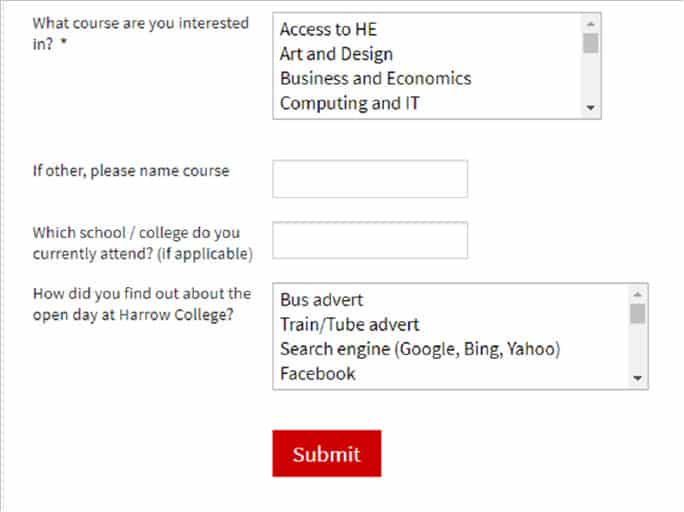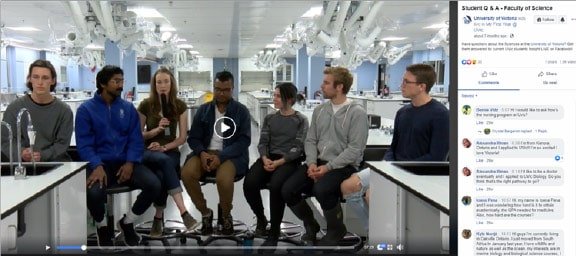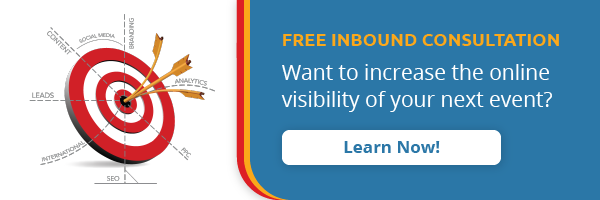
If you’re looking for the undivided attention of prospective students, events provide an excellent opportunity to get your school’s message across to a captive audience. Whether in-person or online, open houses, webinars, information sessions, and other events are excellent opportunities to answer questions, share useful resources, and showcase why your school is a great fit for your prospects.
When parents and students sacrifice their time to attend one of your school’s events, chances are they’re already highly interested. If you maximize event attendance, you’ll amplify interest, and ultimately multiply the number of applications you receive.
However, events require a great deal of time, resources, and effort. It’s crucial that prospects not only attend them – but are adequately followed up with afterwards.
Fortunately, with these tips, you can ensure a significant return on investment for your next event.

1. Make the Most of Your School’s Event Registration Page
A robust digital marketing strategy will help promote your event, but if your registration page is poorly designed, it’s likely that reach will not translate into increased attendance. Before you begin, ensure your registration page is simple, intuitive and includes the key information you need.
Example: University College London created a separate landing page for their ‘Open Days’ event registration.

When considering what fields to include in your registration form, there’s a balance between asking for too much information – potentially leading users not completing it – and asking for too little, which prevents you from personalizing your follow-up strategy.
Example: In addition to basic personal information, Harrow College asks those signing up for an open house 3 short questions – which schools/colleges they attend, what course they are interested in, and how they found out about the event. This approach could help the school to tailor their follow-up efforts towards each student, and evaluate their marketing strategy for future events.

2. Automate Higher Ed Event Invites with Email Workflows
The central challenge with email invitations is ensuring that your message is not buried in an inbox full of spam and promotional material. Email is a highly effective way to attract people to your event – but there’s a very thin line between inviting someone to your event and encouraging them to attend, and inundating that person with unwanted mails. According to Hubspot, 94% of people have cut off communications with a company that sent them irrelevant promotional content.
This is where email workflows come in. By contacting target groups with the right messages at the right time, you can ensure that your event invites are only sent to those who are likely to welcome them.
Simply put, a workflow is a sequence of steps that must be followed in order to complete a particular marketing process. In a marketing automation system, once a lead fulfils certain criteria – such as registering to receive notifications about upcoming events – they can be automatically enrolled in a customized workflow. This initiates certain follow-up activities and ensures they’re carried out at the right time. For events, these follow-up activities could include a reminder email sent to registered guests a few days before the event, or for those who haven’t opened your email, a ‘last call’ email to try and encourage them to sign up.
Your subject line could determine whether people open your email or not, so figure out what matters most to your personas and ensure that’s what they see in their inbox. As your workflow progresses, try an add a sense of urgency to them, too. For instance, your last call mail could have a subject line like, ‘Only 2 days left to sign-up!’.
As for the content, keep your emails short, simple, and engaging. Highlight key details, and make it clear why people will benefit from attending. You can always add a graphic or video to get your message across in a more eye-catching way as well.
Last, but certainly not least, you’ll need a call to action (CTA) linking to your event’s landing page. Since the entire purpose of your email workflow is to encourage people to sign up, make sure your CTA is clear, bold, and inviting.
Example: This webinar invite from London Business School has a clear CTA to drive registrations.

3. Create Content Based on Your Personas’ Interests and Concerns
If a prospective student is interested enough in your school to go and see it in person, or devote their evening to a webinar, they’d most likely also be interested in checking out a short video or reading through an informative blog post. Prospective students often have a lot of questions, concerns, and curiosities, so the more resources you can provide them, the more positive they’ll feel towards your school.
Feel free to share these resources on your website and social media channels before the event to pique interest. You can also direct students to your content during the event (see Tip #7) and share it with them in your follow-up emails (see Tip #8).
Example: When prospective students visit University of Toronto Scarborough’s events page, they’re immediately hooked in by a video showcasing student life on campus, and can sign up for an upcoming event below it.

The important thing to remember is that your content should be relevant to your event personas. If your event is geared towards international students, for example, you could write a blog on obtaining study visas.
Example: The University of British Columbia has an admissions blog which offers helpful information for prospective students. Whether one has questions about financial planning or which program to choose, it’s a useful tool for parents and students that require specific information beyond the scope of your event.

4. Extend your Invite Scope Through Facebook Events
490 million people use Facebook’s Events feature every month, and 73% of brands consider Facebook the most effective social media platform to promote their events according to a recent Bizzabo report.
Creating a Facebook event is simple – the feature is available right on your page – and it’s easy for prospective students to see it through the site’s ‘Discover Events’ section. You can also invite your existing followers to the event to ensure that those already interested in your school are in the loop.
Example: John Cabot University create Facebook Events to promote their info sessions in different cities.

Leading up to the event, you can share videos, photos, blogs, and more on the event page to attract those on the fence and engage those who already plan to attend.
5. Attract Event Attendees with Stories
According to Facebook, stories will soon overtake the news feed as the primary way in which users post content, meaning you should probably get familiar with the new format. With that in mind, what better way to get started than by using the feature to promote your events?
Stories and events are a winning pair: both are exciting, fun, and attractive to prospective students. Events are all about connecting with students, and the emphasis on interaction, creativity and narrative in stories makes it the perfect format for that.
Prior to your event, your school can utilize stories on both Instagram and Facebook to craft original, unique, and memorable slideshows that offer information about it, with CTAs linking to your registration page.
Example: Liverpool University posts fun stories leading up to their open days to get prospects excited about attending.

6. Use Paid Advertising to Attract Prospective Students to Events
When targeted and executed well, paid advertising for events can exponentially grow your reach and provide a significant return on investment. A QS report entitled Maximizing Potential at Student Recruitment Events noted that, “a small amount of ad spend can significantly increase the value you take from an expensive event trip.”
Depending on what kind of event you are planning and your desired reach, you can find the perfect paid advertising solutions to fit your higher education digital marketing strategy.
You can easily create ads on Google, Facebook, Instagram, and numerous other networks for your event. These ads can range from simple sponsored posts to dynamic, interactive content.
Google Ads can be a great option for events, as you can create campaigns targeted around specific keywords and searches your audience are likely to use. Through the “Geotargeting” feature, you can also specify which location, or set of locations, you would like your ads to be shown in. You can exclude certain areas for an even more targeted approach.
Example: From ‘webinar” to ‘open house’ to ‘information session’, there are numerous keywords prospective students could use when searching for a school event.
In this case, Yale got it right. The school added a sitelink extension onto its Google ad so prospective students could be easily directed to upcoming events through the ‘Attend An Event’ section.

Social media advertising could also prove very fruitful for your school in this situation. There are numerous ad format options on Facebook and Instagram which could work for event promotion, including two specifically for events which use your Facebook Event as their foundation. The first is used to generate event responses by presenting key information and asking users to click “Interested” or “Going” on your event. The second is specifically for ticket sales; instead of the “Interested” and “Going” buttons, users can click on a link to go to your registration page.
Example: University of Colorado Denver Business School created a Facebook Ad which directs those interested to reach its registration page.

Remarketing is also a highly targeted way to orchestrate your event ads. For those unfamiliar with it, remarketing is essentially when you target ads to those who have previously visited your website (or a specific web page). This can be a great way to reach leads who have already shown interest in your school, but may not be aware of your event.
While Facebook, Google, and Instagram are digital melting pots of users of different ages and locations, with widely varying interests, LinkedIn users tend to fit a more defined persona – which is advantageous to some types of schools more than others. Advertising on LinkedIn is particularly effective for universities and business schools as those with lofty career and education goals tend to frequent the platform.
LinkedIn also offers the unique advantage of directing ads towards those of a particular education level or profession – a win for higher ed events in particular. For example, if you’re hosting an event for your graduate business program, you can ensure that those who see your ads already have their Bachelor’s degree, as well as any relevant professional experience you might require.
Example: LinkedIn’s Sponsored InMail is a great way to attract attendees. A recruiter from Queens’ MBA program utilized InMail advertising to notify prospective students of their online information session.

7. Engaging Attendees During Your Higher Ed Event
Digital engagement with prospective students doesn’t stop when your event starts. From hashtags to Facebook Live, there are many ways you can engage with attendees during your event to further connect them to your school.
Hashtags are a great way to not only engage with attendees, but to encourage people to promote your event – and by extension, your school. Hashtags are now used across all social media platforms, but they have particular traction on Twitter. According to HubSpot, your tweets can have 12x higher engagement if you use the right hashtags.
Prior to your event, decide on a key hashtag that you can promote before, during, and after the event. Perhaps you already have one that you can use.
Example: Guelph University promotes the hashtag #futuregryphon at admissions events.

Make sure your event hashtag is visible during your event; include it in handouts and display it on screens throughout your venue. Encourage audience members to use the hashtag, and like or retweet those who do.
Hashtags are also very useful for online events. You can prompt webinar viewers to use the hashtag and let others know they are watching.
Another great way to promote your event as it happens is through Facebook Live. Your school can stream and record it for those who are busy during your event or unable to travel.
Facebook Live videos not only produce 6x more interactions than traditional videos – they also have features to further engage audiences and make them feel more like they are part of the event. Viewers can comment and react while watching a livestream, making it a more interactive process than watching a traditional video.
Example: The University of Victoria ensures that all their events – big or small – are livestreamed on Facebook. Notice that viewers are chiming in with questions in the comments section.

While broadcasting your livestream, make sure that you record it, too. That way, you can save and upload it onto your website for viewing later.
Example: The University of Victoria has a webpage dedicated to their Facebook Live archives.

8. Following up with Prospective Students After Your Event
Once you’ve promoted your event, attracted a large audience, and showcased your school to those interested, what’s next?
To convert attendees into applicants, it is highly important to follow up with them – whether by email, phone, text, or a combination thereof.
Since the decision of where to attend university, which career college is best, or which language school to go to is one that requires immense thought and research, chances are that your event is not the only one prospects will attend. Without a good follow-up strategy, you may be letting leads fall through the cracks.
To ensure a thorough, well-organized follow-up process, a good CRM and marketing automation system can be a godsend for your higher education digital marketing strategy, and this is especially true when it comes to events. As mentioned in Tip #3, a comprehensive and customizable CRM system will allow you to create workflows to automate your email process for specific events, and this can include follow-up mails as well.
Any follow-up content you create – whether shared through email, text, or a messaging platform – should be tailored based on a prospective student’s stage in the enrollment journey. Those who have attended your events can likely be taken to have demonstrated a high degree of interest in your school, so now might be the perfect time to direct them to your application page. For those still on the fence, ensure they have ample resources to answer any remaining questions they may have. You should also encourage attendees to subscribe to your school’s newsletter and follow your social media channels so you can keep them further in the loop.
The event type should also influence the follow-up process. For physical events, direct attendees to additional online resources to supplement the information they received at your event. As for online events, you could offer to send attendees – as well as those who missed the event – a recording of it for review.
From pre-event promo, to in-event engagement, to post-event follow-up, there are numerous ways your school can optimize every stage of the event process. With these higher ed digital marketing tips, your team can make sure you get it right.






